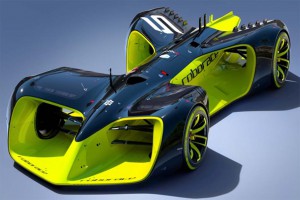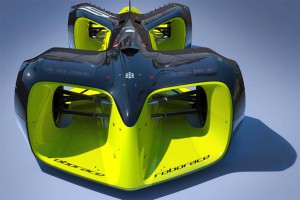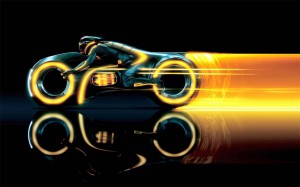
The worlds of fantasy and autonomous vehicles are merging together with the kickoff of the Robocar racing series.
We’re going to have to wait a few years before the first fully autonomous vehicles roll into U.S. showrooms, but expect to start seeing them on the track later this year, and you can give credit – or blame – to the same man who designed the vehicles in the sci-fi films Tron: Legacy and Oblivion.
While specific details haven’t been released, expect to see 20 of these robocars when the first roborace is held as a support series for the FIA Formula E Championship during the 2016-2017 season. There will be 10 teams, each operating two of the electrically powered autonomous vehicles.
It makes some sense to push the envelope when you’re developing cars for the first autonomous race cars, which will compete in the new Robocar series. And who better to turn to than designer Daniel Simon, who has also worked on everything from drones to motorcycles, and even spaceships.
The 40-year-old German began his career in 1999 for Volkswagen AG and eventually worked on a variety of the maker’s brands, including Seat, Lamborghini and Bugatti. He left VW in 2005 and revealed his fixation on futuristic automotive designs with the best-selling “Cosmic Motors,” published in 2007.
Simon also worked on both Tron: Legacy and the follow-up Tron: Oblivion, as well as 2011’s Captain America: The First Avenger.
But, in some ways, his work on the new Robocar might be Simon’s most challenging project yet, bringing together fantasy and a technology now moving from science fiction to reality.

With vehicle designs borrowing from the Tron movies, the new Robocar series kicks off later this year.
(Magna turning to the public to garner new ideas in auto safety. For more, Click Here.)
“We’re living in a time where the once-separated worlds of the automobile and artificial intelligence collide with unstoppable force,” he says. “The Roborace is as much about competition as it is entertainment. Therefore – and quite unusual in today’s racing world – beauty was very high on our agenda and we work hard to merge the best performance with stunning styling.”
A beautiful, distinctive design was high on the list of priorities. That said, the Robocar needs to actually perform well when it’s on the track, so aerodynamics were a critical element of the design, Simon adds.
“It was important to us that we generate substantial downforce without unnecessary parts cluttering the car to maintain a clean and iconic look,” he explains. “This is largely made possible by using the floor as the main aerodynamic device.”
With no need for a cockpit or the requisite safety equipment meant to protect a driver, the Robocar is primarily a long beam in which the batteries and electric propulsion system, as well as the autonomous drive technology, will be located.
(Click Here for details about why an increase in leasing has analysts worried.)
While specific details of the car haven’t been released, Simon hints that development is far from complete, with the current focus on developing active body parts he suggests will be “more organic and seamless” than what we see on today’s Formula 1 racers, or even the cars that are part of the newer Formula E series.
That said, the Robocar will have a lot in common with the vehicles in the battery-car series. All 20 of the autonomous racers will be mechanically identical, though each team will customize their own software, if nothing else. Capable of speeds estimated to reach 190 mph, they’ll be produced by a company called Kinetik.
Due to the limits of today’s lithium-ion battery technology, the Robocars will only be able to handle half of each one-hour race – the same challenge the human-operated Formula E cars face – meaning they will have to come into the pits, a second car emerging onto the track.
Formula E is in the middle of its 2015-2016 season. It has not yet been announced when the first Roborace will take place. Also yet to be revealed is what teams will compete.
(To see more about Tesla’s new Model 3 sedan, Click Here.)
For now, sponsors would only say in a prepared release that, “The first Roborace ‘shows’ will take place during the 2016-2017 Formula E season with disruptive and innovative new formats showcasing safety and extreme driving capabilities.”


If this is the future of racing looks like I will stop being a fan .
Why on earth would people watch this for any length of time?
If no human is driving and competing, what’s the point?
I can tell you for certain that I don’t watch my washing machine do its work, and I generally care about those results!
-john